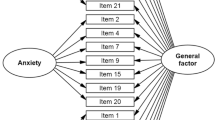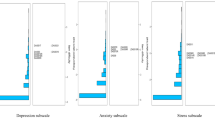Abstract
Anxious-depression symptomatology is frequently encountered among Latina/o individuals. There is a dearth of studies that examine this mixed class of anxiety and depression symptomatology, especially among Latina/o college students by the US-Mexico border. A total of 505 participants from rural institutions of higher education completed the DASS21. Psychometric properties were measured by means of confirmatory and exploratory factor analysis (EFA). A multivariate analysis of variance (MANOVA) was conducted to determine gender differences in depression, anxiety and stress. Among women, 18 % reported at least moderate levels of depressive symptoms, 33.1 % reported at least moderate levels of anxiety symptoms, and 16.4 % reported at least moderate levels of stress. In men, 15.9 % reported at least moderate levels of depressive symptoms, 34.1 % reported at least moderate levels of anxiety symptoms, and 12.9 % reported at least moderate levels of stress. The EFA supported a one dimension factor (anxious/stress-depression) among this sample of Latina/o college students (Bartlett’s test = 4960.9; df = 210; p ≤ 0.01; Kaiser–Meyer–Olkin = 0.95). The MANOVA found no significant gender differences in depression, anxiety symptomatology and stress [Wilks’Λ = 0.99; F = (3, 500) = 2.41; p = 0.07]. The DASS-21 showed a one dimensional construct of anxious/stress-depression symptomatology in a Latina/o rural undergraduate sample, raising awareness to the need to screen and monitor this constellation of symptoms.
Similar content being viewed by others
References
Familiar I, Borges G, Orozco R, Medina-Mora M-E. Mexican migration experiences to the US and risk for anxiety and depressive symptoms. J Affect Disord. 2011;130:83–91.
Vega WA, Sribney WM, Aguilar-Gaxiola S, Kolody B. 12-month prevalence of DSM-III-R psychiatric disorders Among Mexican Americans: nativity, social assimilation, and age determinants. J Nerv Mental Dis. 2004;192:532–41.
Camacho Á, Gonzalez P, Buelna C, et al. Anxious-depression among Hispanic/Latinos from different backgrounds: results from the Hispanic Community Health Study/Study of Latinos (HCHS/SOL). Soc Psychiatry Psychiatr Epidemiol. 2015;50:1669–77.
Ionescu DF, Luckenbaugh DA, Niciu MJ, et al. Effect of baseline anxious depression on initial and sustained antidepressant response to ketamine. J Clin Psychiatry. 2014;75:e932–8.
Silverstone PH, von Studnitz E. Defining anxious depression: going beyond comorbidity. Can J Psychiatry. 2003;48:675–80.
American Psychiatric Association. Diagnostic and statistical manual of mental disorders. DSM-5, vol. 184. Washington DC: American Psychiatric Publishing; 2013.
Fava M, A John Rush M, Alpert JE, et al. Difference in treatment outcome in outpatients with anxious versus nonanxious depression: a STAR* D report. Am J Psychiatry. 2008.
Cleary P, Guy W. Factor analysis of the Hamilton depression scale. Drugs Exp Clin Res. 1977;1:115–20.
Merikangas KR, Jin R, He J-P, et al. Prevalence and correlates of bipolar spectrum disorder in the World Mental Health Survey Initiative. Arch Gen Psychiatry. 2011;68:241–51.
Frasure-Smith N, Lesperance F. Depression and anxiety as predictors of 2-Year cardiac events in patients with stable coronary artery disease. Arch Gen Psychiatry. 2008;65:62–71.
Eisenberg D, Hunt J, Speer N. Mental health in American colleges and universities: variation across student subgroups and across campuses. J Nerv Ment Dis. 2013;201:60–7.
Wadsworth ME, Hudziak JJ, Heath AC, Achenbach TM. Latent class analysis of child behavior checklist anxiety/depression in children and Adolescents. J Am Acad Child Adolesc Psychiatry. 2001;40:106–14.
Lovibond SH, Lovibond PF. Manual for the Depression Anxiety Stress Scales. 2nd ed. Sydney: Psychology Foundation; 1995.
Brown TA, Chorpita BF, Korotitsch W, Barlow DH. Psychometric properties of the depression Anxiety Stress Scales (DASS) in clinical samples. Behav Res Ther. 1997;35:79–89.
Gloster AT, Rhoades HM, Novy D, et al. Psychometric properties of the Depression Anxiety and Stress Scale-21 in older primary care patients. J Affect Disord. 2008;110:248–59.
Antony MM, Bieling PJ, Cox BJ, Enns MW, Swinson RP. Psychometric properties of the 42-item and 21-item versions of the Depression Anxiety Stress Scales in clinical groups and a community sample. Psychol Assess. 1998;10:176-81.
Page AC, Hooke GR, Morrison DL. Psychometric properties of the Depression Anxiety Stress Scales (DASS) in depressed clinical samples. Br J Clin Psychol. 2007;46:283–97.
Wood BM, Nicholas MK, Blyth F, Asghari A, Gibson S. The utility of the short version of the Depression Anxiety Stress Scales (DASS-21) in elderly patients with persistent pain: does age make a difference? Pain Med. 2010;11:1780–90.
Vignola RCB, Tucci AM. Adaptation and validation of the Depression, Anxiety and Stress Scale (DASS) to Brazilian Portuguese. J Affect Disord. 2014;155:104–9.
Duffy CJ, Cunningham EG, Moore SM. Brief report: the factor structure of mood states in an early adolescent sample. J Adolesc. 2005;28:677–80.
Osman A, Wong JL, Bagge CL, Freedenthal S, Gutierrez PM, Lozano G. The Depression Anxiety Stress Scales—21 (DASS-21): further examination of dimensions, scale reliability, and correlates. J Clin Psychol. 2012;68:1322–38.
Yusoff MSB. Psychometric properties of the Depression Anxiety Stress Scale in a sample of medical degree applicants. Int Med J. 2013;20:295–300.
Tran TD, Tran T, Fisher J. Validation of the Depression Anxiety Stress Scales (DASS) 21 as a screening instrument for depression and anxiety in a rural community-based cohort of northern Vietnamese women. BMC psychiatry. 2013;13:24.
Norton PJ. Depression Anxiety and Stress Scales (DASS-21): psychometric analysis across four racial groups. Anxiety Stress Coping. 2007;20:253–65.
Tully PJ, Zajac IT, Venning AJ. The structure of anxiety and depression in a normative sample of younger and older Australian adolescents. J Abnorm Child Psychol. 2009;37:717–26.
Sinclair SJ, Siefert CJ, Slavin-Mulford JM, Stein MB, Renna M, Blais MA. Psychometric evaluation and normative data for the depression, anxiety, and stress scales-21 (DASS-21) in a nonclinical sample of US adults. Eval Health Prof. 2012;35:259–79.
Henry JD, Crawford JR. The short-form version of the Depression Anxiety Stress Scales (DASS-21): construct validity and normative data in a large non-clinical sample. Br J Clin Psychol. 2005;44:227–39.
Gomez R. Depression Anxiety Stress Scales: Factor structure and differential item functioning across women and men. Personal Individ Differ. 2013;54:687–91.
Gomez R, Summers M, Summers A, Wolf A, Summers JJ. Depression Anxiety Stress Scales-21: factor structure and test–retest invariance, and temporal stability and uniqueness of latent factors in older adults. J Psychopathol Behav Assess. 2014;36:308–17.
Patrick J, Dyck M, Bramston P. Depression Anxiety Stress Scale: is it valid for children and adolescents? J Clin Psychol. 2010;66:996–1007.
Oei TP, Sawang S, Goh YW, Mukhtar F. Using the Depression Anxiety Stress Scale 21 (DASS-21) across cultures. Int J Psychol. 2013;48:1018–29.
Mellor D, Vinet EV, Xu X, Mamat NHB, Richardson B, Román F. Factorial invariance of the DASS-21 among adolescents in four countries. Eur J Psychol Assess. 2015;31:138–42.
Shea TL, Tennant A, Pallant JF. Rasch model analysis of the Depression, Anxiety and Stress Scales (DASS). BMC Psychiatry. 2009;9:21.
Szabó M. The short version of the Depression Anxiety Stress Scales (DASS-21): Factor structure in a young adolescent sample. J Adolesc. 2010;33:1–8.
Dunn MG, O’Brien KM. Psychological health and meaning in life: stress, social support, and religious coping in Latina/Latino immigrants. Hisp J Behav Sci. 2009;31:204–27.
Apóstolo JLA, Mendes AC, Azeredo ZA. Adaptation to Portuguese of the Depression, Anxiety and Stress Scales (DASS). Revi Latino-Am de Enferm. 2006;14:863–71.
Vasconcelos-Raposo J, Fernandes HM, Teixeira CM. Factor structure and reliability of the Depression, Anxiety and Stress Scales in a large Portuguese community sample. Span J Psychol. 2013;16:E10.
Antúnez Z, Vinet EV. Escalas de depresión, ansiedad y Estrés (DASS-21): validación de la versión abreviada en estudiantes universitarios Chilenos. Ter Psicol. 2012;30:49–55.
Bados A, Solanas A, Andrés R. Psychometric properties of the Spanish version of Depression, Anxiety and Stress Scales (DASS). Psicothema. 2005;17:679–83.
Fonseca-Pedrero E, Paino M, Lemos-Giráldez S, Muñiz J. Propiedades psicométricas de la Depression Anxiety and Stress Scales-21 (DASS-21) en universitarios españoles. Ansiedad y Estrés. 2010;16(2/3):215–26
Daza P, Novy DM, Stanley MA, Averill P. The Depression Anxiety Stress Scale-21: Spanish translation and validation with a Hispanic sample. J Psychopathol Behav Assess. 2002;24:195–205.
Gil AG, Vega WA. Two different worlds: Acculturation stress and adaptation among Cuban and Nicaraguan families. J Soc Pers Relationsh. 1996;13:435–56.
Romero AJ, Roberts RE. Stress within a bicultural context for adolescents of Mexican descent. Cultur Divers Ethnic Minor Psychol. 2003;9:171–84.
Concha M, Sanchez M, de la Rosa M, Villar ME. A longitudinal study of social capital and acculturation-related stress among recent latino immigrants in South Florida. Hisp J Behav Sci. 2013;35:469–85.
Lorenzo-Seva U, Ferrando PJ. FACTOR: a computer program to fit the exploratory factor analysis model. Behav Res Methods. 2006;38:88–91.
Mardia KV, Foster K. Omnibus tests of multinormality based on skewness and kurtosis. Commun Stat Theory Methods. 1983;12:207–21.
Baglin J. Improving your exploratory factor analysis for ordinal data: a demonstration using FACTOR. Pract Assess Res Eval. 2014;19:2.
Marotta SA, Garcia JG. Latinos in the United States in 2000. His J Behav Sci. 2003;25:13–34.
Guarnaccia PJ, DeLaCancela V, Carrillo E. The multiple meanings of ataques de nervios in the Latino community. Med Anthropol. 1989;11:47–62.
Guarnaccia PJ, Rubio-Stipec M, Canino G. Ataques de nervios in the Puerto Rican diagnostic interview schedule: the impact of cultural categories on psychiatric epidemiology. Cult Med Psychiatry. 1989;13:275–95.
American Psychiatric Association. Diagnostic and statistical manual of mental disorders. 4th ed. Arlington, VA: American Psychiatric Publishing, Inc.; 2014.
Sarmiento IA, Cardemil EV. Family functioning and depression in low-income Latino couples. J Marital Family Ther. 2009;35:432–45.
Nuñez A, González P, Talavera GA, et al. Machismo, marianismo, and negative cognitive-emotional factors: findings from the Hispanic community health study/study of Latinos Sociocultural Ancillary Study. J Latina/o Psychol. 2015;. doi:https://doi.org/10.1037/lat0000050.
Lewis-Fernández R, Hinton DE, Laria AJ, et al. Culture and the anxiety disorders: recommendations for DSM-V. Depress Anxiety. 2010;27:212–29.
Alcántara C, Abelson JL, Gone JP. Beyond anxious predisposition: do padecer de nervios and ataque de nervios add incremental validity to predictions of current distress among Mexican mothers? Depress Anxiety. 2012;29:23–31.
Kessler RC, Sampson NA, Berglund P, et al. Anxious and non-anxious major depressive disorder in the World Health Organization World Mental Health Surveys. Epidemiol Psychiatr Sci. 2015;27:1–17.
Camacho A. Is anxious-depression and inflammatory state? Med Hypotheses. 2013;81(4):577–81.
Katon W, PP Roy-Byrne. Mixed anxiety and depression. J Abnorm Psychol. 1991;100:337–45.
Ionescu DF, Niciu MJ, Mathews DC, Richards EM, Zarate CA. Neurobiology of anxious depression: a review. Depress Anxiety. 2013;30:374–85.
Castilla-Puentes R, Sala R, Ng B, Galvez J, Camacho A. Anxiety disorders and rapid cycling: data from a cohort of 8129 youths with bipolar disorder. J Nerv Ment Dis. 2013;201:1060–5.
Johnson SL, Carver CS, Joormann J. Impulsive responses to emotion as a transdiagnostic vulnerability to internalizing and externalizing symptoms. J Affect Disord. 2013;150:872–8.
Acknowledgments
Ms. Tara Perkins is currently a doctoral student in the School of Nursing and Health Innovation at Arizona State University.
Author information
Authors and Affiliations
Corresponding author
Rights and permissions
About this article
Cite this article
Camacho, Á., Cordero, E.D. & Perkins, T. Psychometric Properties of the DASS-21 Among Latina/o College Students by the US-Mexico Border. J Immigrant Minority Health 18, 1017–1023 (2016). https://doi.org/10.1007/s10903-016-0415-1
Published:
Issue Date:
DOI: https://doi.org/10.1007/s10903-016-0415-1




